Quick Answer:
Wintering over means using your greenhouse to protect existing plants through cold weather with minimal growth or maintenance. It focuses on insulation and frost protection rather than active production.
Winter growing keeps your greenhouse climate-controlled for active cultivation through the winter months, using heat, ventilation, and supplemental light to maintain growth.
The right approach depends on your growing goals. Choose winter over for plant preservation and lower energy costs, or winter growing for true four-season harvests.
- What Does It Mean to Winter Over Plants?
- What is Winter Growing and How Does it Work?
- Winter Over Vs. Winter Growing: Key Differences
- How to Choose the Right Approach for Your Winter Greenhouse
- Energy and Cost Consideration for Your Winter Greenhouse
- Real-World Examples of Winter Greenhouse Setups
- From Planning to Planting: Design Your Winter Greenhouse
When winter settles in, your greenhouse becomes more than a structure; it's a decision point. Some gardeners use their space to simply protect plants from frost, while others keep their growing season alive all year long. Understanding the difference between wintering over and winter growing helps you design the right setup for your goals, climate, and budget.
The Concept of Winter Over
What does it mean to winter over plants in a greenhouse? This section explains how overwintering works and how to create an effective overwintering greenhouse setup.
Purpose of Wintering Over
Preserve, not produce.
Wintering over means using your greenhouse as a protective space rather than a production zone. Instead of cultivating new crops, you're keeping tender perennials, potted citrus, or tropical plants alive through the cold months.
Typical Wintering Over Conditions:
- Temperatures hover just above freezing (around 2 to 5°C / 35 to 40°F)
- Minimal heating and supplemental light
- Heavy reliance on insulation and solar gain
Recommended Greenhouse Setup For Overwintering
- Twinwall or fivewall polycarbonate glazing for energy efficiency
- Bubble insulation or thermal curtain for extra protection
- Small heater unit with thermostat control
- Circulating fan to prevent moisture buildup
Greenhouse Best Fit for Wintering Over
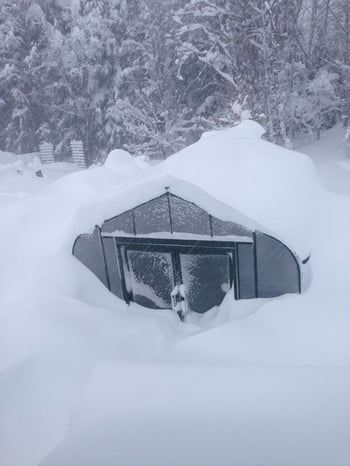
Pacific Greenhouse
The Pacific features a curved eave profile that helps shed snow and handle wind. It is a strong all-season option for gardeners who want reliable weather performance with a distinctive look. Pair with twinwall glazing for improved insulation when overwintering.
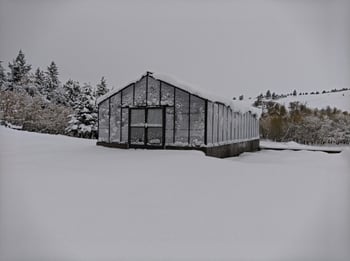
Traditional Greenhouse
The Traditional model offers a classic straight-eave design with excellent air circulation and strong thermal insulation. It is perfect for gardeners in colder regions who need dependable frost protection and consistent interior temperatures.
Pro Tip: Add thermal mass such as water barrels or stone flooring. They absorb warmth during the day and release it overnight, helping stabilize interior temperatures.
The Concept of Winter Growing
What does it mean to grow actively through the winter? This section explains how winter growing works and how to create a productive greenhouse setup that thrives through the cold season.
Purpose of Winter Growing
Grow through the cold.
Winter growing means maintaining a controlled environment that supports active plant growth throughout the coldest months. Instead of closing down for the season, you're cultivating cool-weather crops like leafy greens, herbs, and even certain fruiting plants by managing light, heat, and airflow.
Typical Winter Growing Conditions
- Stable temperature between 10 to 24°C / 50 to 75°F
- Supplemental heating and lighting during short winter days
- Steady airflow and humidity management to prevent disease
Recommended Greenhouse Setup for Winter Growing
- Double Glass or low-E glazing for strong insulation
- Thermostat-controlled gas or electric heating system
- LED grow lights to extend daylight hours
- Automated vents or circulation fans for consistent airflow
Greenhouse Best Fit for Winter Growing
.jpg?width=350&name=photo%204%20(Large).jpg)
Meridian Estate Greenhouse
Meridian Estate Greenhouses are BC Greenhouse Builders' premium bespoke models designed for gardeners who want luxurious and high-performing spaces to grow year-round. They combine heavy-duty aluminum framing with high-performance low-E double glass for exceptional insulation, strength, and weather resistance.
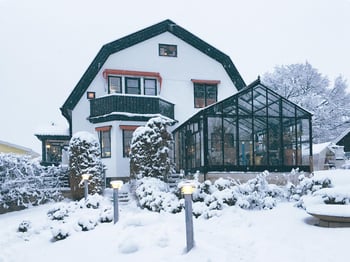
Attached Greenhouses
Attached models connect directly to your home, making it convenient and energy efficient. The shared wall helps retain heat while providing easy access to your plants year-round.
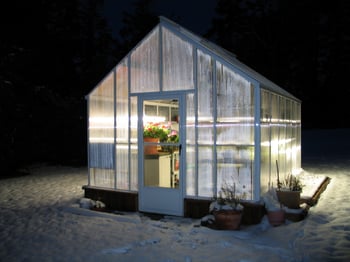
Cottage Greenhouse
Cottage models combine classic design with practical strength. Its steeper roof pitch allows excellent light capture during low-sun months, while the structure itself provides reliable insulation or ongoing winter harvests.
Pro Tip: Group plants by their heat requirements. Keep cool-loving crops lower to the ground and position tropicals or fruiting plants higher where the warm air collects.
Comparing the Two Approaches
| Features | Winter Over | Winter Growing |
| Main Goal | Protect plants from frost | Maintain active growth |
| Temperature Range | 2 to 7°C 35 to 45°F |
10 to 24°C 50 to 75°F |
| Energy Use | Low | Moderate to High |
| Crop Type | Ornamentals, perennials, tender shrubs | Vegetables, herbs, tropicals |
| Equipment Needs | Basic greenhouse heater, insulation, fan | Full heating, thermostat, lighting |
| Maintenance | Low | High |
| Ideal Models | Pacific, Traditional | Meridian Estate, Attached, Cottage |
Choosing What Fits Your Winter Garden Goals
Ask Yourself:
- Do I want to harvest in winter or simply preserve what I have?
- What are my local temperature lows?
- How much time do I want to spend managing the greenhouse?
- What's my comfort level with heating costs?
If you love low-maintenance protecting and efficiency from your greenhouse, winter over may be perfect. If you crave the satisfaction of harvesting your own greens in January, winter growing delivers that year-round payoff.
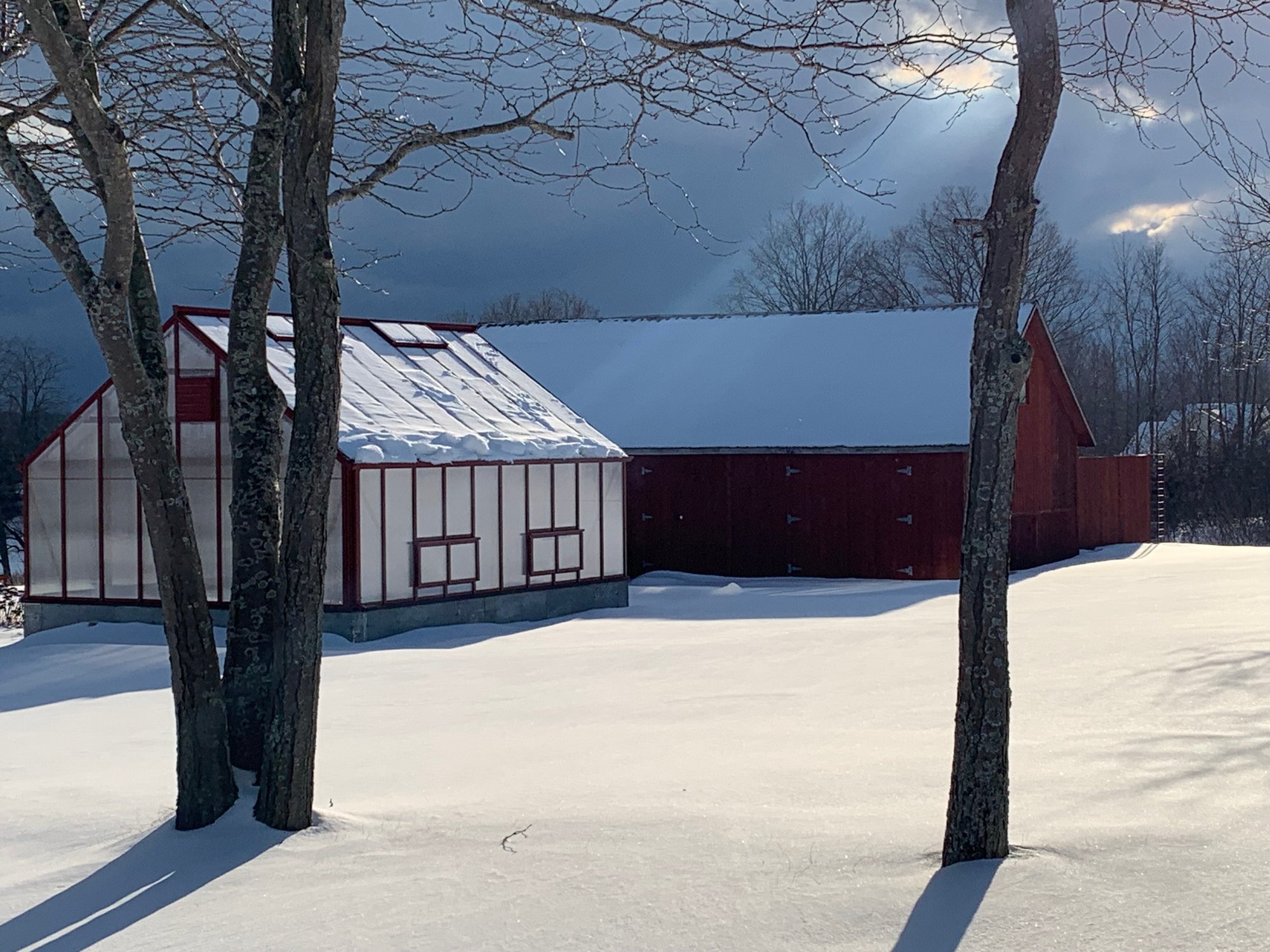
Energy and Cost Consideration for Your Winter Greenhouse
Heating is often the biggest variable between these two approaches. The warmer you maintain your greenhouse, the higher your energy use climbs. You can make either method more efficient by adding:
- Double glazing or insulated glass for better heat retention
- Thermal mass (brick, concrete, or water barrels)
- Automatic venting to reduce humidity loss
- Programmable thermostats to maintain stable temperatures
Even modest upgrades can make a major difference in comfort and energy savings.
Climate Control Planning
Every BC Greenhouse is designed with your climate in mind. During the design phase, our experts consider heating, cooling, and ventilation requirements specific to your growing goals. Whether you want to maintain frost protection or build a four-season food source, we tailor the glazing and equipment recommendations to fit your region.
Real-World Examples
Winter Over with Fluent Garden in BC, Canada
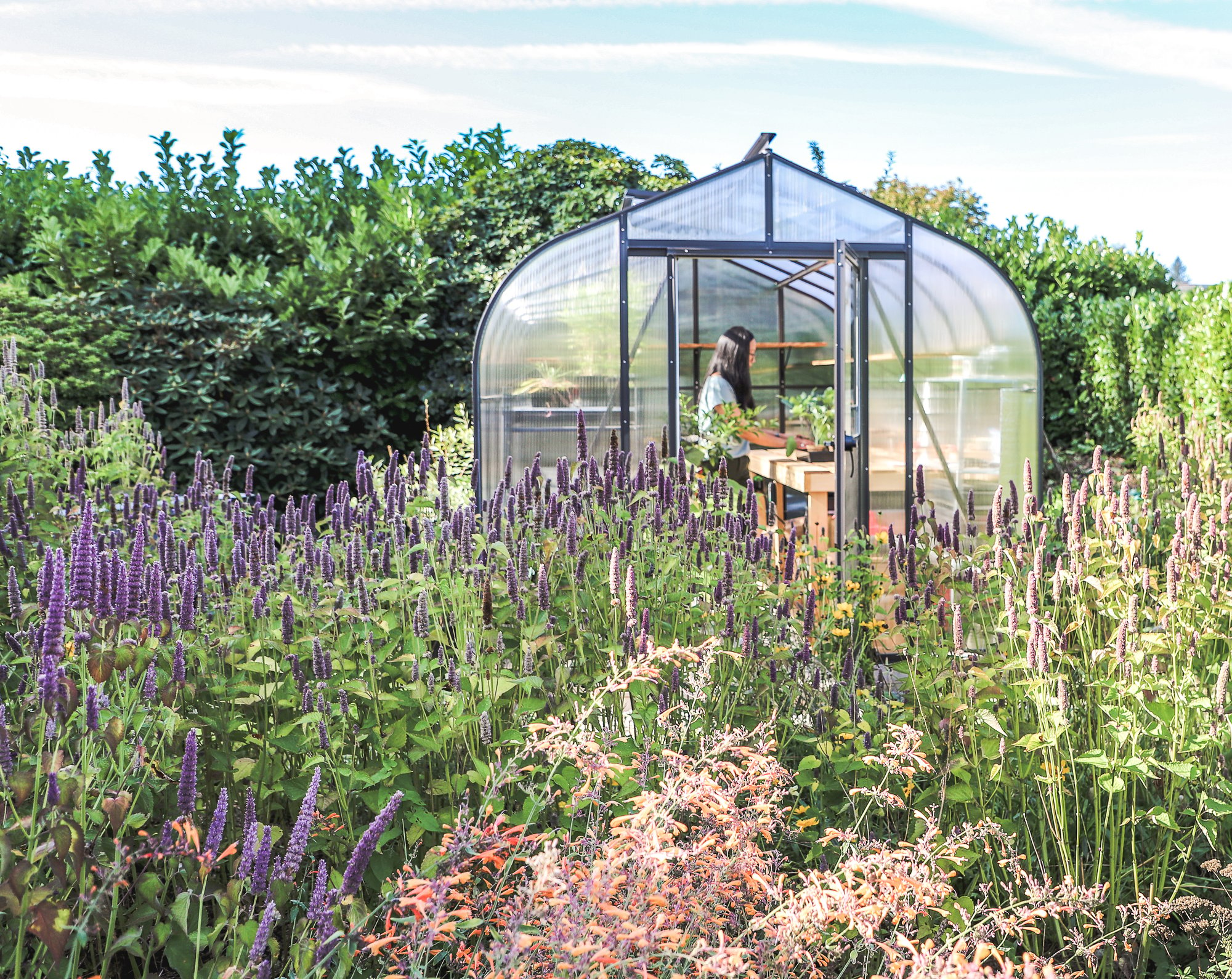
Christina's Pacific greenhouse, seen frequently in our catalog, is used to winter over her many gardening experiments including quinoa and subtropicals. Located in Zone 8b, she keeps her space heated at 12°C/54°F and relies on bubble wrap insulation to reduce energy costs.
Winter Growing in Montana, US
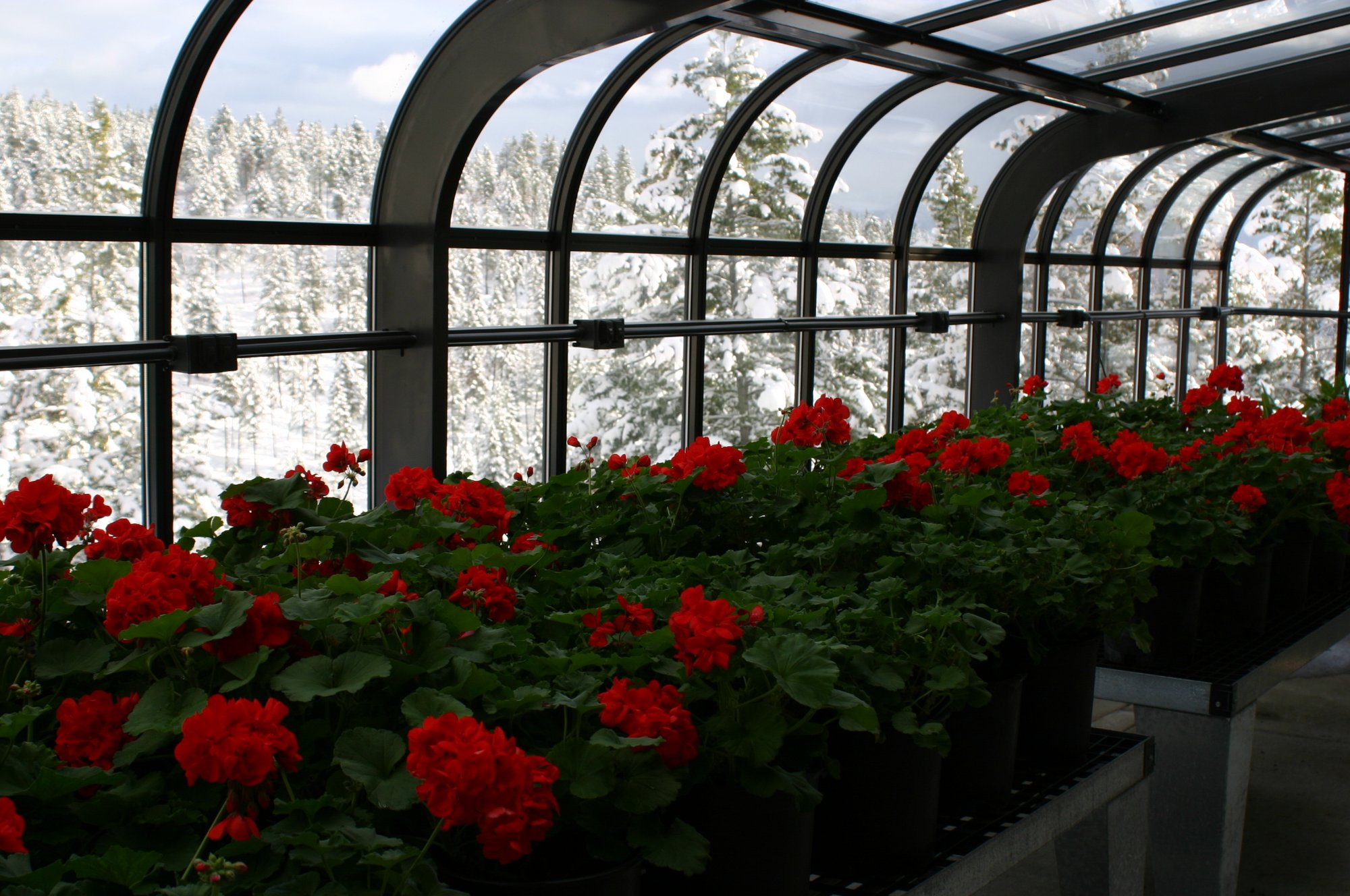
This Meridian Estate Greenhouse combines double-glass glazing and an a attached design to be able to keep greens and flowers alive year-round. Located in Zone 4b, this structure also includes thermostatic control to keep the greenhouse at comfortable temperature, especially in winter.
From Planning to Planting
Whether you're overwintering delicate plants or cultivating a full winter garden, the key is planning a greenhouse that works with your lifestyle and local climate. Both approaches—Winter Over and Winter Growing—can transform the colder months into productive, restorative time in the garden. With the right structure, insulation, and temperature control, you'll keep your plants thriving and your passion for growing alive no matter the forecast.
Need help choosing the right greenhouse setup for your winter goals?
BC Greenhouse Builders' Greenhouse Experts are ready to guide you through glazing options, heating systems, and design features that match your growing goals.



